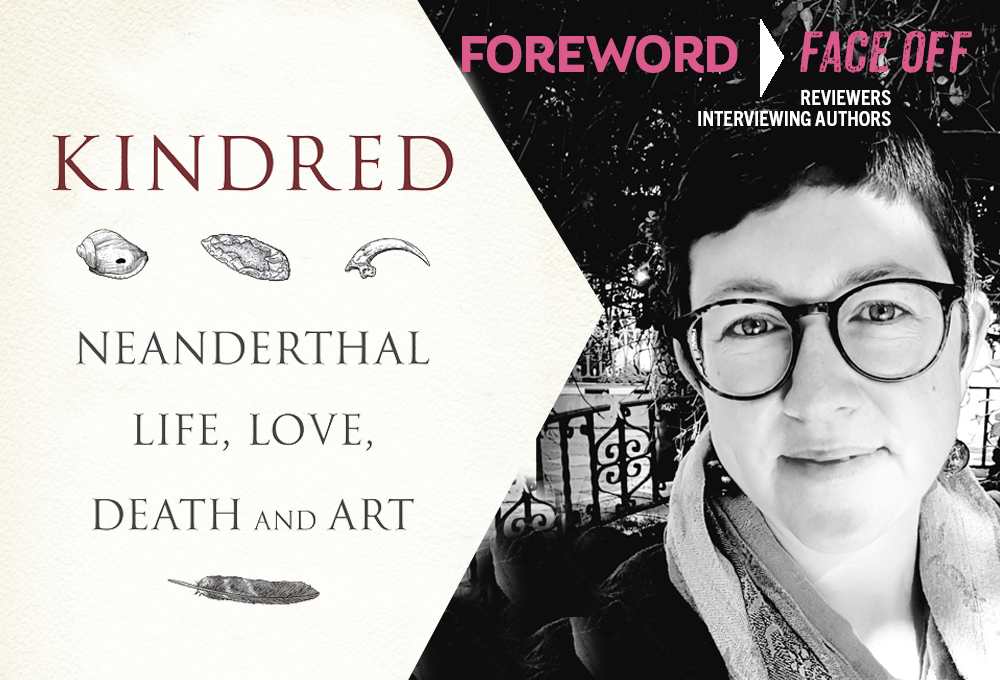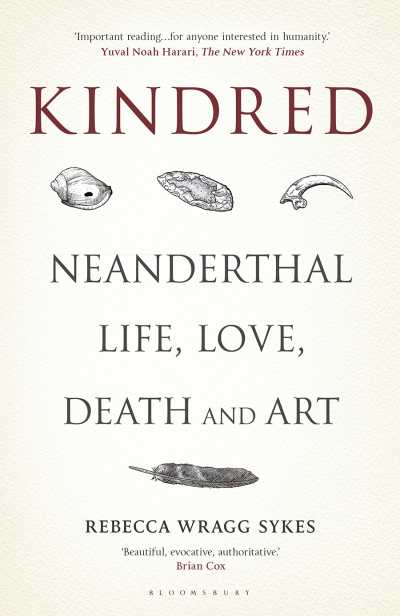Reviewer Rachel Jagareski Interviews Rebecca Wragg Sykes, Author of Kindred: Neanderthal Life, Love, Death, and Art

You’re not alone if you have relatives who occasionally cause you to cringe with embarassment, and if you could peek further back in your family tree you’d certainly find a slew more ne’er-do-wells. But don’t include your Neanderthal ancestors—that’s right: 2.0 percent or so of your DNA is Neanderthal—among the cringeworthy in your bloodline because new research is showing that Homo sapiens and other hominin species were interbreeding with Neanderthals for at least 150,000 years and the ’derthals were amply evolved comparatively. In other words, if you would have brought one home for dinner, your mother would have approved.

If they could, Neanderthals would send a hearty grunt of gratitude to this week’s guest, Rebecca Sykes, for Kindred: Neanderthal Life, Love, Death, and Art—which will go a long way in repairing their shabby reputation. Our own Rachel Jagareski granted the book a starred review in Foreword’s March/April issue and an author-reviewer conversation about this fascinating chapter of prehistoric history was too compelling to pass up.
Illustrations and creative interpretations about what individual Neanderthals might have thought and experienced lead off each chapter. It is a successful and engaging way to introduce various aspects of Neanderthal culture. Was this blend of fiction and nonfiction planned from the genesis of your book design or did it evolve later?
This kind of literary rather than scientific writing has always been part of me, I love language and poetry, and even when reading scientific articles, I am immediately visualising what a particular site looked like, say 60,000 years ago; even what it smelled like. I didn’t exactly plan to include what I think of as these “narrative vignettes” in the book; it evolved as I wrote. But the very first thing I wrote was the beginning of what would become chapter 12, an informed imagining of the birth and death of a newborn infant, inspired both by real skeletons and also by the fact I had myself recently had a child.
In recent years there have been a number of new archaeological finds involving Neanderthals and other ancient humans, as well as a raft of discoveries from fresh analysis of older sites, remains, and artifacts using new technologies. What do you think will be the next biggest discovery about Neanderthal culture based on these new methods?
That’s tricky, but one thing I can say with confidence is that many surprises await us! Certainly the research from ancient DNA is only just getting going—it’s only twelve years since we got the draft Neanderthal genome, and already the methods have advanced hugely. I’d love to see continuing collaboration between geneticists and archaeologists to unpick the social context of the final 20 millennia of Neanderthal life (60–40,000 years before present). We can look forward to increasingly complex understanding of contact between them and other hominins, including early Homo sapiens, but the social and cultural context, where and when it happened is still elusive. I predict that within the next decade we will see more and more interbreeding being identified, and maybe even find a first generation Neanderthal-sapiens hybrid (as has already happened with Denisovans).
Your chapters on Neanderthals’ lithic technology reveal sophisticated manufacture and use of stone tools, but I was most surprised to learn about the extensive use of other materials, like coal, birch tar, and twists of plant fiber for household use, personal adornment, and art/ceremonial purposes. What were some of the most startling things that you learned about this material culture as you researched this book?
Having worked as an academic specialising in Neanderthals and especially stone tool technology for a decade before I started the book, I already had a good knowledge of this and other aspects of their material culture. But it’s a testament to the richness of the archaeological record and the energy of the researchers who work on it that, despite my own expertise, there was still so much to learn! And new discoveries all the time.
I really enjoyed writing about wooden objects, because as with so much in Neanderthal life, the deeper we look, the more we recognise skill, selection, and systematic thought about what they were doing. Digging sticks for example were just as carefully worked as spears: the species and even part of the tree chosen for their material qualities, and similar consideration shown in the ways they were carved and an angle to the wood grain, presumably because it makes the tips more robust.
It was interesting to read about how our cultural fascination with Neanderthals as the “ultimate Other” connects to nineteenth-century colonialism and racial biases dating from the first archaeological discoveries of Neanderthal sites. You call for wider publication of non-Western and Indigenous examination of archaeological evidence to offer different scientific and cultural perspectives. Is this beginning to happen? Is it being well enough funded and published?
There have been Indigenous archaeologists and scientists exploring the world for millennia, but it is only lately that their historic and modern contributions have begun to be recognised by the Western scientific mainstream. I’m far from an expert in this field, but what’s clear is that promotion of those voices is crucial not just for better science—diversity in perspectives on the world means more possibilities for understanding the past, including the Neanderthals—but also as a means for Indigenous scholars and communities to lead research agendas that have long taken an extractive approach their cultures and even DNA.
As you note, most of us modern humans have a small percentage of Neanderthal DNA, which is responsible for an array of mental and physical characteristics. As the number of Neanderthal remains increases, what other characteristics do you hope we might have inherited from our ancient ancestors?
Most people today have 1.5–2.4 percent Neanderthal DNA (for people from sub-Saharan African backgrounds, it’s much less). It’s still very early however for understanding exactly how that genetic legacy is manifested in living humans, and what it means for our bodies and minds today. Recent analysis suggests that in fact virtually all of our genome is shared with other hominin species, and there is only a relatively small percentage that’s uniquely sapiens; moreover, interbreeding was going on for probably more than 150,000 years. So by the final millennia of the Neanderthals, both they and us were far more similar than ever before.
The climate crisis underscores the wastefulness and consumerism of our modern lifestyles. What lessons can Neanderthals teach us about living more lightly on the Earth?
Neanderthals lived through many cycles of climate change, including one period even warmer than present (and where we may well be heading in the next century). However, if things got tough then they had more possibilities to move than our massive and dense human populations today. One striking thing is that extinction may often have included chance, and cleverness might not necessarily have been enough to avoid it. We can see that some of the early Homo sapiens dispersing into Eurasia well before 50,000 years ago also largely disappeared around the same time as Neanderthals, for example. There’s an impression emerging from current research that what set apart those who did persist might have been conviviality and stronger social networks. We can use our inventiveness today to tackle the climate crisis, but technology isn’t enough; it’s crucial that we also draw on our unique capacity for collaboration and cooperation.
Rachel Jagareski
